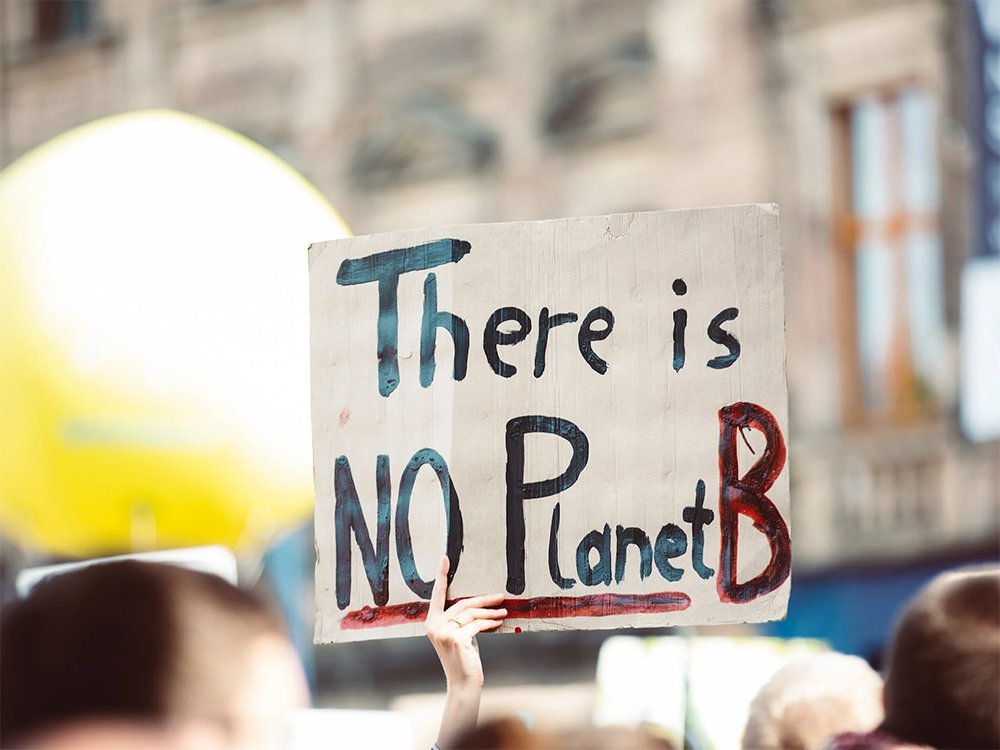
In a joint statement earlier this summer, the U.N. World Meteorological Organization (WMO) and European Union’s Copernicus Climate Change Service told us that July 2023 would be the hottest month on record. Their assessment was correct. Phoenix, Arizona hit 110 degrees Fahrenheit for 31 days straight, breaking every record since the city’s conception. In the Middle East, temperatures almost exceeded the limits of human survival with the heat index reaching up to 152 degrees Fahrenheit. Rising temperatures are creating a new reality for us, one that involves suffocating summers and relentless heat that pushes the bounds of our infrastructure, air conditioners, and patience.
According to the United Nations, the fashion industry is responsible for 10 percent of human-caused greenhouse gas emissions and 20 percent of global wastewater. If production practices are not properly assessed, the industry and consumers alike will continue to face the worsening effects of climate change. As burdensome heat waves blaze across the nation, what we wear matters more than ever. The new way to support climate resilience is to support fashion sustainability and clothing that helps us survive our new normal.
The industry’s response to rising temperatures is crucial to setting us on the right track to create safer conditions for everyone, including frontline workers who have no choice but to bear the heat. Its commitment to sustainable practices is the best way to ensure we are on the right track to stagnating climate change as best we can.
To reframe our perspective on climate change, it’s vital to acknowledge the concrete progress being made. Several brands and designers have committed to changing the trajectory of the fashion industry by remedying unsustainable practices and addressing the need for more durable, functional, and ecologically-friendly attire.
Stella McCartney
Stella McCartney, the UK-based luxury designer and lifelong vegetarian, has long been committed to cruelty-free design and limiting her brand’s environmental footprint. McCartney has been revolutionizing the industry since the release of her first collection in the early 90s, creating modern ready-to-wear runway fashion. She has embarked on hallmark eco-friendly projects like the vegan Stan Smith trains in Autumn 2018 and the first-ever luxury handbags and garments to be made out of mycelium fungus.
McCartney creates cruelty-free, PVC-free garments out of reengineered cashmere, organic cotton, and recycled textiles. In 2014, McCartney also launched her Clevercare initiative at the Copenhagen Fashion Summit to extend the life of garments, reduce the need for wash cycles, and reduce water and energy consumption.
View this post on Instagram
Eileen Fisher
Eileen Fisher, the New York City-based designer is dedicated to redefining the traditional linear production process to create a circular design model. Known for her simple, minimalistic garments, Fisher’s designs utilize renewable, regenerative, and recyclable fabrics as a part of their “Circular by Design” program.
One part of the Circular by Design program is her “Renew” initiative, where consumers can return their Eileen Fisher clothing to any US Eileen Fisher or Renew Store and receive $5 in rewards per item returned. This effort to extend the lifecycle of clothing directly lowers the carbon footprint of the company and ensures that quality pieces don’t go to waste.
View this post on Instagram
Gabriela Hearst
Gabriela Hearst, the creative director of Parisian fashion house Chloé, launched her own brand in 2015 based on the principle of sustainability and the traditional renewable practices of Hearst’s Uruguayan heritage. Hearst creates timeless, chic, and elevated staples all while using deadstock and recycled materials, such as the merino wool of her family’s sheep farm in Uruguay. The brand also utilizes TIPA-flexible packaging to limit its plastic consumption and is committed to creating carbon-neutral shows at Paris Fashion Week.
Since taking over Chloé in 2020, Hearst has significantly improved the brand’s sustainability trajectory. The brand now uses roughly 60% “lower impact” materials, has stopped making cotton t-shirts to reduce their water consumption, and uses recycled cotton, linen, and hemp to make their denim. Hearst’s belief that fashion should not come at the expense of the environment shows in her continued commitment to renewable practices.
View this post on Instagram
Mara Hoffman
Mara Hoffman’s namesake brand of bold colors, prints, and shapes was founded in 2000. Fifteen years later, she shifted her brand to operate around a framework of sustainability, encouraging mindful consumption habits and encouraging women to reevaluate the relationship they have with their clothing. Hoffman even has a secondhand shop called “Full Circle,” a dedicated space for consumers to buy and sell pre-owned Mara Hoffman garments.
Utilizing sustainable fabrics for a number of her collections, her swimwear line uses nylon and polyester fibers derived from waste or recycled plastics. Her ready-to-wear collections also feature organic plant-based materials and ethically sourced alpaca wool. Using innovative techniques like digital printing and reusing material byproducts, the brand has stayed true to its commitment to creating a fully transparent, sustainable supply chain.
View this post on Instagram
Roopa Pemmaraju
Roopa Pemmaraju’s colorful, feminine, and bold designs are designed in New York and created by an artisan team in India. Each Pemmaraju garment is sewn by hand using traditional techniques and natural or recycled fabrics such as cotton, corn fiber, eucalyptus, and silk. Beyond offering competitive and fair wages to her workers, Pemmaraju invests in lower waste production practices such as hand weaving, digital printing, and hand block printing.
With no two garments being alike, Pemmaraju reimagines a production process in which style is not defined by wasteful and ever-changing trend cycles.
View this post on Instagram
Article by Zoe Hussain for The Untitled Magazine


